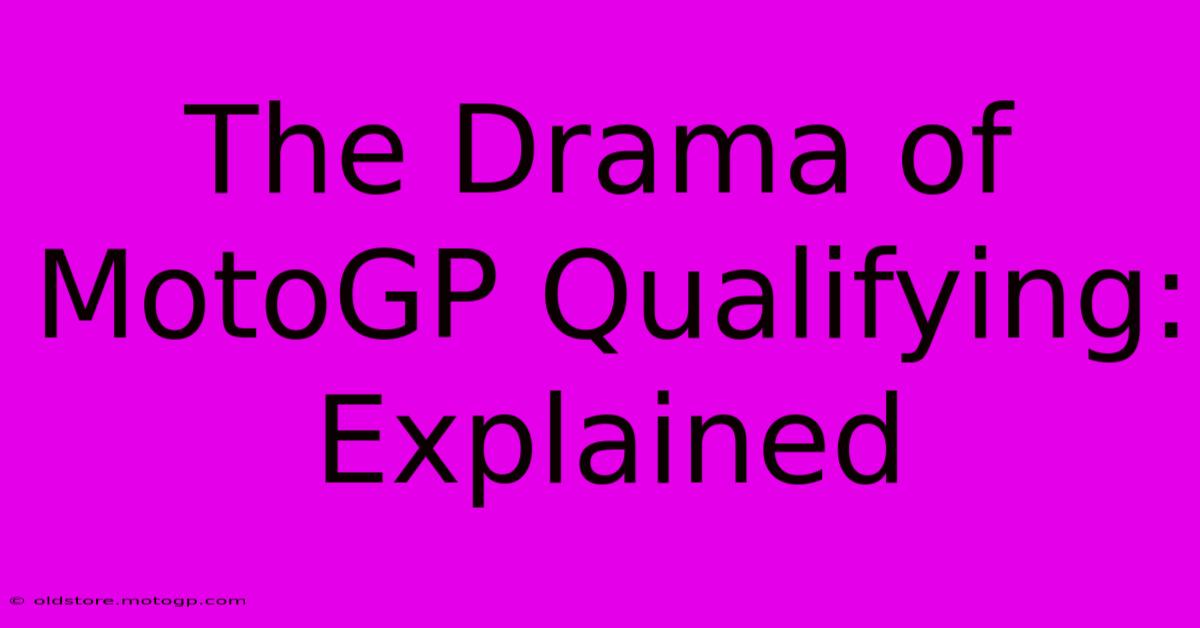The Drama Of MotoGP Qualifying: Explained

Table of Contents
The Drama of MotoGP Qualifying: Explained
MotoGP qualifying. The very words conjure images of screaming engines, breathtaking speed, and nail-biting tension. But what actually happens during those crucial sessions that determine starting grid positions? This article breaks down the drama of MotoGP qualifying, explaining the format, the strategies, and the high stakes involved.
Understanding the Qualifying Format
MotoGP qualifying isn't a simple "fastest lap wins" affair. It's a multi-stage process designed to maximize excitement and showcase rider skill. The current format typically involves:
Q1 (Qualifying 1):
- Participants: The riders who didn't finish within the top 10 in the combined times of Free Practice 1, 2, and 3 (FP1, FP2, FP3). This often includes riders who had mechanical issues or struggled with setup in the practice sessions.
- The Goal: The top two fastest riders from Q1 automatically progress to Q2. The remaining riders start the race from positions 13-24. The pressure is immense; a single mistake can ruin their race weekend.
Q2 (Qualifying 2):
- Participants: The top 10 riders from the combined free practice times, plus the two fastest riders from Q1.
- The Goal: This is where the real fight begins. The top 10 riders from Q2 secure their positions on the starting grid, with the fastest rider claiming pole position. The competition is fierce, with riders pushing their machines and themselves to the absolute limit.
The Strategic Dance: More Than Just Speed
While raw speed is essential, MotoGP qualifying is a complex strategic game. Teams meticulously analyze data from free practice sessions to optimize bike setup for the qualifying runs. Factors such as tire choice, fuel load, and track temperature significantly impact performance.
Tire Management:
Choosing the right tires is critical. Riders must balance the need for grip and speed with the tire's lifespan. A set of soft tires might deliver the fastest lap time, but could wear out before the end of the qualifying session, leaving the rider vulnerable.
Slipstreaming:
Slipstreaming, or drafting, plays a significant role in qualifying. Riders will strategically position themselves behind another rider to reduce air resistance and gain a significant speed advantage. Mastering the art of slipstreaming and timing the overtake is crucial for securing a good qualifying position.
Track Conditions:
The track temperature and weather conditions change throughout the qualifying sessions. Teams and riders constantly monitor these changes, adapting their strategies accordingly. A sudden rain shower can completely shuffle the pack and change the qualifying outcome.
The High Stakes: Why Qualifying Matters
The starting grid position in MotoGP is incredibly important. A front-row start offers a significant advantage, reducing the risk of collisions and providing an opportunity to break away from the pack early in the race. Conversely, starting further back makes winning significantly more difficult.
Impact on Race Strategy: A good starting position influences race strategy, allowing riders to conserve tires and fuel or adopt a more aggressive overtaking approach.
The Drama Unfolds: What Makes it so Exciting
The combination of high speeds, intense competition, and the pressure of performing under the spotlight creates an atmosphere of unparalleled drama. Every tenth of a second counts, and unexpected mechanical issues or rider errors can dramatically alter the qualifying outcome.
Unpredictability: The unpredictable nature of MotoGP qualifying adds to the excitement. A seemingly unfancied rider can snatch pole position, while a championship favorite might struggle to make it out of Q1.
Tension: The tension builds throughout the sessions, reaching fever pitch in the final minutes of Q2 as riders battle for pole. The live commentary, close camera angles, and post-qualifying interviews all contribute to the overall drama.
MotoGP qualifying is more than just a time trial; it's a captivating display of skill, strategy, and high-stakes competition. The drama it creates is a testament to the dedication, talent, and sheer bravery of the world's best motorcycle racers. Understanding the format and the strategies involved deepens appreciation for the incredible feats these riders achieve each and every race weekend.

Thank you for visiting our website wich cover about The Drama Of MotoGP Qualifying: Explained. We hope the information provided has been useful to you. Feel free to contact us if you have any questions or need further assistance. See you next time and dont miss to bookmark.
Featured Posts
-
Moto 2 Bike Specs The Power Of Braking Systems
Feb 20, 2025
-
Push Your Limits With Moto Gp 23 On Ps 5
Feb 20, 2025
-
Us Gp Concerts Make Some Noise
Feb 20, 2025
-
Cota Store Shop Now And Show Your Racing Spirit
Feb 20, 2025
-
Austin F1 Shuttle Your Ticket To The Grand Prix
Feb 20, 2025
